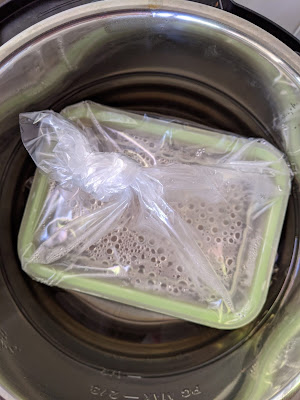Please see here and here to learn more about concentrated lactic acid sourdough (CLAS).
Because of COVID, we all minimize traveling. I haven't seen my friends for a long time, especially those who live afar. To reconnect with them, I made Rus's Ukrainian loaf and sent it to them with other homemade goodies. The bread was well received. My friends' wives all want to learn how to make it, but some are somewhat confused about the process. I summarized the steps to the bare minimum to help them start using CLAS ASAP to bake.
- Understand how concentrated lactic acid sourdough ("CLAS") works. Read the following blog post up to the point where video clips appear.
https://brotgost.blogspot.com/p/clas.html
2. Then, watch the following videos in which the baker demonstrates how to make CLAS. You may choose either one of the two methods to make it, depending on the available ingredients.
a. Video 1 - the preferred method, watch up to 6:51
https://youtu.be/iPQV8qcwK1M
b. Video 2 - watch from 2:30 to 8:41
https://youtu.be/niIcAuRRxWo 3. Recap
Temperature control in the required range is crucial for successfully producing a flavorful loaf.
I set up a water bath in the Instant Pot, support the container with a trivet, and use the Instant Pot's yogurt feature to make CLAS:

then cover it with the lid.
Unfortunately, I developed this water-bath method when I constantly deal with my annoying proofer's inability to maintain a target temperature. It drives me crazy. You don't need to do it this way when using an instant pot, but it ensures a stable temperature of the medium, and I don't have to monitor it with (multiple) thermometers.
P.S. 20230722 





I can also make CLAS in the Zo using its 'Rise 3' feature because it operates within the same temperature range as a yogurt maker. I can either take out the bread pan, place the container with CLAS in the bread machine, supporting it with a trivet, or ferment the CLAS directly in the bread pan.
To make CLAS with rye, you will need:
Rye or any other malt: 25g
Whole-grain rye flour: 75g
Water T. 45°C: 180 ml
Vinegar (5%acidity): 10 ml
Fermentation temperature: 40°C±2°C
Fermentation time: 24-36h
Hydration: 190%
End pH: around 4
To refresh rye CLAS
1:10 (rye flour in CLAS : new rye flour), 190% hydration @ 40+-2C x 12 hours
To make CLAS with wheat, you will need:
wheat malt: 25g
Whole grain wheat flour: 75g
Water T. 45°C: 140 ml
Vinegar (5% acidity): 10 ml
Fermentation temperature: 38°C±2°C
Fermentation time: 24-36h
Hydration: 150%
End pH: around 4
To refresh wheat CLAS
1:7 (wheat flour in CLAS: new wheat flour),150% hydration@38+-2 C x 12 hours
I usually make about 500g of CLAS at a time with 200g of grains. It stays in the fridge until I need it to bake, and I stir it thoroughly before use. I usually warm it up with one of Zo's fermentation features while I prepare the remaining ingredients. When I've used up most of the 500g of CLAS, I refresh it using the 1:7 ratio to make another 500g, give or take.
4. If you are new to bread making, read the "What do you need to purchase to get started?" section in the following blog post before proceeding further.
https://brotgost.blogspot.com/2020/03/blog-post.html
Making Rus's Ukrainian Palyanitsa loaf
- Watch the following video in which Rus shows how to make Ukrainian Palyanitsa with CLAS.
https://youtu.be/tpNqhC5s_Ck
2. Formula and procedure
CLAS 101.5 g (hydration 190%, 35g wholemeal rye, and 66.5g water)
(can be fresh or from fridge pre-warmed up to 30C/86F
Flour 665 g (high gluten flour German 812/or use bread flour)
Water 350 g (30-35C/86-95F)
Dry yeast 4.6 g
Salt 10.5-14 g(table salt use10.5g, kosher salt use 14g)
Total 1,144.5g
65% hydration = water weight / flour weight
(Dough temperature 30-33C/86-91.4F)
Bulk fermentation
90 minutes at 30-33C/86-91.4F
Fold
the dough according to the video
Rest
30 minutes at 30C/86F
Shape
Final proof
25 minutes at 32 C/89.6F
Preheat the oven to 250C/482F
(It may take an hour+ to preheat the oven with the baking stones, so plan accordingly)
Score
Bake
8-10 minutes 250C/482F with steam
then 40 minutes 190С/374F